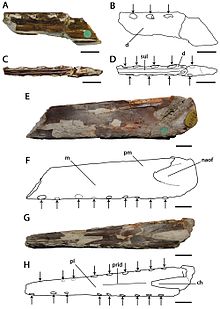Lonchodectidae
| Lonchodectids | |
|---|---|

| |
| Material referred to Lonchodectes | |
| Scientific classification | |
| Domain: | Eukaryota |
| Kingdom: | Animalia |
| Phylum: | Chordata |
| Order: | †Pterosauria |
| Suborder: | †Pterodactyloidea |
| Clade: | †Ornithocheiromorpha |
| Family: | †Lonchodectidae Hooley, 1914 |
Genera
| |
| Synonyms | |
| |
Lonchodectidae or Lonchodraconidae
Taxonomic history

Lonchodectidae was first named by paleontologist
Description
The most diagnostic features of Lonchodectidae pertain to the teeth and jaws. The teeth on both the upper and lower jaws are generally small, do not vary in size through the length of the jaw, and are placed on raised alveolar margins. The upper palate has a prominent ridge. One genus, Lonchodraco, has prominent crests at the tips of both the skull and mandible, while another, Ikrandraco, only has a crest on the mandible. Only Lonchodraco and Ikrandraco preserve postcrania, which is similar to other
Classification

The cladogram below is a topology recovered by Longrich and colleagues in 2018. In their analysis, they placed the family Lonchodectidae as the sister taxon of the family Boreopteridae, while also placed within the more inclusive group Ornithocheiromorpha.[15]
Other studies including Pêgas et al. (2019) and Holgado & Pêgas (2020) however, have only included Ikrandraco and Lonchodraco in this group, therefore using the name Lonchodraconidae instead.[1][2]
Paleobiology
Lifestyle
Postcranial material similar to those of azhdarchoids has previously been referred to Lonchodectes;[16] however, this material has later been referred to the azhdarchoid Ornithostoma.[17] Ikrandraco is presumed to have been piscivorous, though this is not completely confirmed.[18] Lonchodraco bore sensor pits similar to those of modern probe feeding birds; though it appears to be unlikely that it was a probe feeder due to its large size and broad jaw ends, it has been suggested that it similarly procured food items on the ground or in water such as fish or insects.[19]
References
- ^ a b Pêgas, R.V., Holgado, B., Leal, M.E.C., 2019. "Targaryendraco wiedenrothi gen. nov. (Pterodactyloidea, Pteranodontoidea, Lanceodontia) and recognition of a new cosmopolitan lineage of Cretaceous toothed pterodactyloids", Historical Biology, 1–15. doi:10.1080/08912963.2019.1690482
- ^ .
- ISBN 1-86239-143-2.
- ^ Unwin, D.M. (2008)
- ^ Witton, M.P., Martill, D.M., and Green, M. (2009). "On pterodactyloid diversity in the British Wealden (Lower Cretaceous) and a reappraisal of “Palaeornis” cliftii Mantell, 1844." Cretaceous Research, 30: 676–686.
- S2CID 84617119.
- ^ .
- ^ Pterosaurs: Natural History, Evolution, Anatomy, Mark P. Witton (2013)
- ^ Hooley, R.W. 1914. "On the Ornithosaurian genus Ornithocheirus with a review of the specimens from the Cambridge Greensand in the Sedgwick Museum, Cambridge", Annals and Magazine of Natural History, series 8, 78: 529-557
- ^ Unwin, David M. 2001. "An overview of the pterosaur assemblage from the Cambridge Greensand (Cretaceous) of Eastern England". Mitteilungen as dem Museum für Naturkunde, Berlin, Geowissenschaftliche Reihe 4: 189–222
- PMID 23794925.
- ^ J. Lü, S. Ji, C. Yuan, Y. Gao, Z. Sun and Q. Ji. 2006. New pterodactyloid pterosaur from the Lower Cretaceous Yixian Formation of Western Liaoning. Papers from the 2005 Heyuan International Dinosaur Symposium. Geological Publishing House, Beijing 195-203
- ^ Witton, Mark P. (2013). Pterosaurs: Natural History, Evolution, Anatomy
- S2CID 133080548.
- ^ Pterosaurs: Natural History, Evolution, Anatomy, Mark P. Witton (2013)
- ^ Averianov, A.O. (2012). "Ornithostoma sedgwicki – valid taxon of azhdarchoid pterosaurs." Proceedings of the Zoological Institute RAS, 316(1): 40–49.
- PMID 25210867.
- S2CID 225130037.
